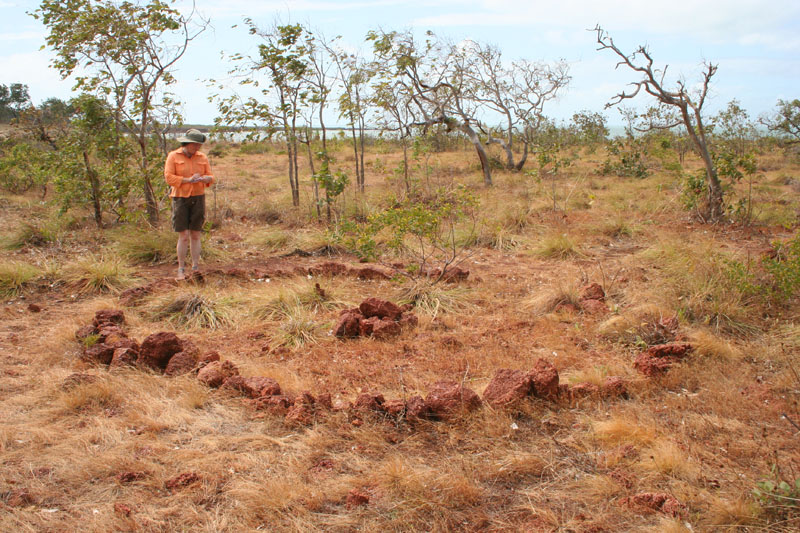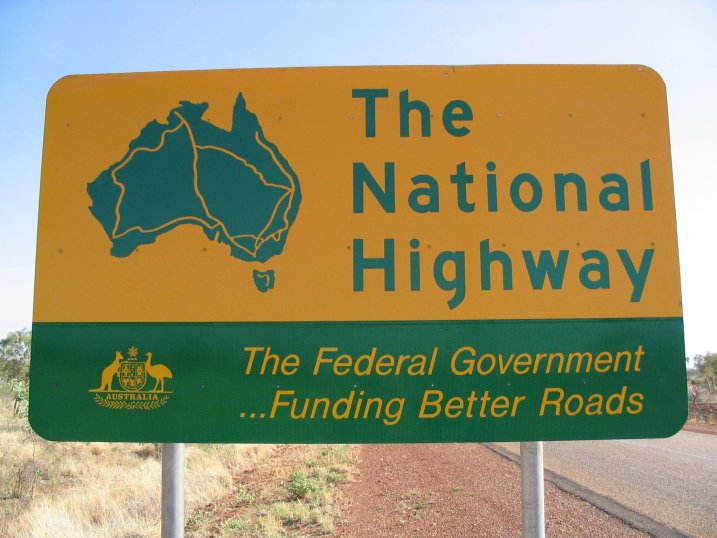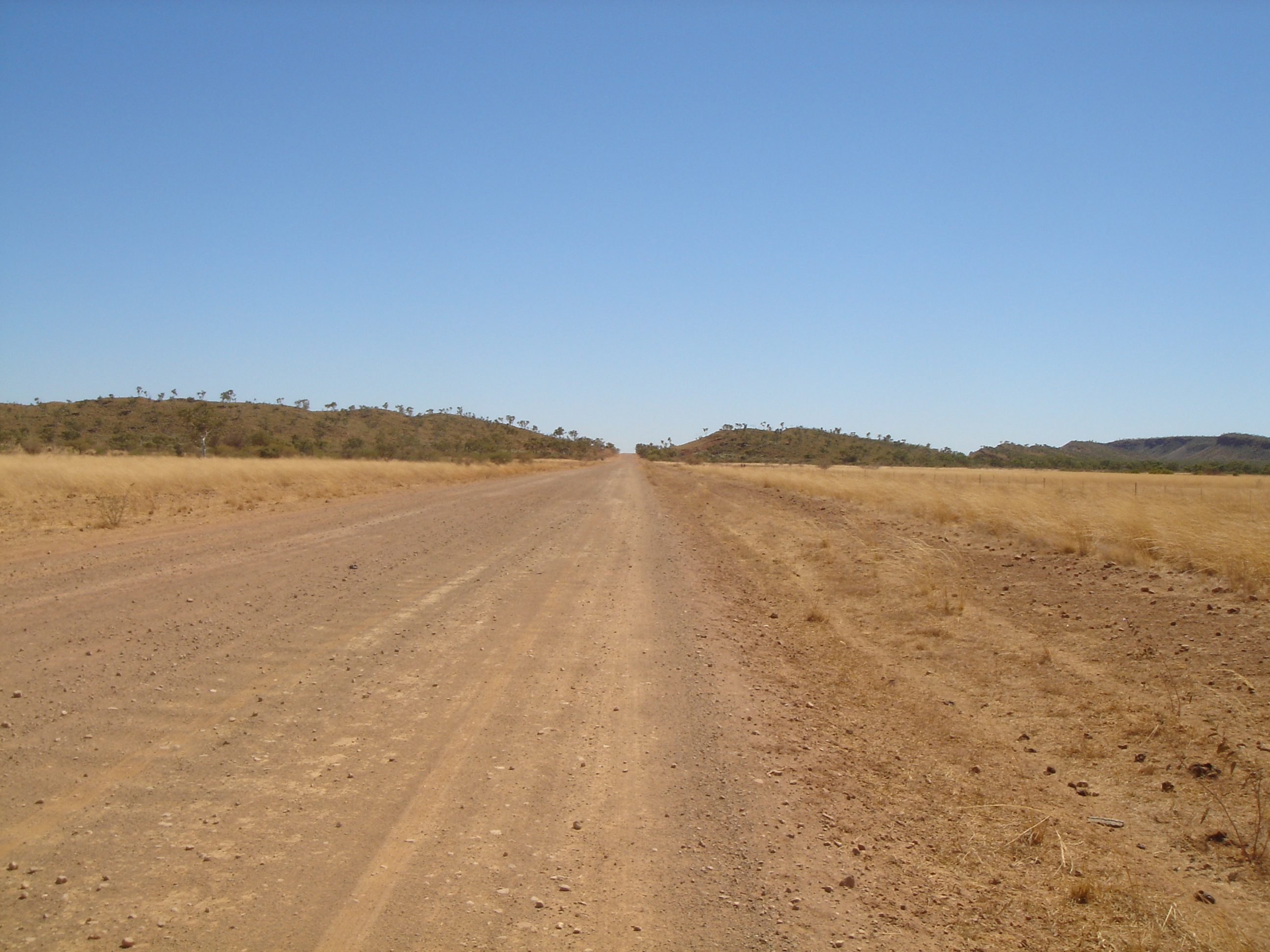|
Central Arnhem Road
The Central Arnhem Road, also referred to as the Central Arnhem Highway or locally as "The Track", is a designated state route in the Northern Territory of Australia linking the Stuart Highway to the town of Nhulunbuy on the Gove Peninsula and communities across the East Arnhem region. It connects over 12,000 residents and is a key tourism drive and freight route for the mining and pastoral industries. Text was copied from this source, which is available under Creative Commons Attribution 4.0 International License The route traverses through Aboriginal Land and passes through the Aboriginal communities of Barunga, Beswick and Bulman. A free permit from the Northern Land Council is required for non-indigenous persons to travel its length. Australian 4WD Action ranked the drive 5''th'' in its list of 20 "must drive" four-wheel drive tracks in Australia in 2010. Present conditions The vast majority of the road is unsealed and is prone to seasonal (December - April) floo ... [...More Info...] [...Related Items...] OR: [Wikipedia] [Google] [Baidu] |
Stuart Highway
Stuart Highway is a major Australia, Australian highway. It runs from Darwin, Northern Territory, Darwin, in the Northern Territory, via Tennant Creek and Alice Springs, to Port Augusta in South Australia; a distance of . Its northern and southern extremities are segments of Australia's Highway 1 (Australia), Highway 1. The principal north–south route through the central interior of mainland Australia, the highway is often referred to simply as "The Track". The highway is named after Scotland, Scottish explorer John McDouall Stuart, who was the first European to cross Australia from south to north. The highway approximates the route Stuart took. Route description Overview Stuart Highway runs from Darwin, Northern Territory, in the north, via Tennant Creek and Alice Springs, to Port Augusta, South Australia, in the south – a distance of . The Royal Flying Doctor Service of Australia, Royal Flying Doctor Service uses the highway as an emergency landing strip and sections ... [...More Info...] [...Related Items...] OR: [Wikipedia] [Google] [Baidu] |
Bulldust
Bulldust or bull dust is a fine, soft and powdery red aeolian dust that is common across Australia, especially in the Outback and desert. Bulldust is a type of fugitive dust that when disturbed can have dangerous effects. Bulldust is common on remote roads, especially in the far north of Australia where the wet and dry season can cause the roads to either be boggy or very dry. Bulldust is also an Australian colloquial term and euphemism. Both meanings of the term originated in the 1920s. Causes and general description Most soils in Australia have no structure, and their surface often contains medium to high amounts of fine sand. Because of the lack of structure when compressed or disturbed, bulldust will form. These disturbances can be anything that breaks up the track surface, such as a car or vehicle driving along a road, or a pack of animals such as camels running through the desert. Once the road surface has been disturbed, the bulldust particles released into the air can ... [...More Info...] [...Related Items...] OR: [Wikipedia] [Google] [Baidu] |
Yirrkala
Yirrkala is a small community in East Arnhem Region, Northern Territory, Australia, southeast of the large mining town of Nhulunbuy, Northern Territory, Nhulunbuy, on the Gove Peninsula in Arnhem Land. Its population comprises predominantly Aboriginal Australians of the Yolngu people, and it is also home to a number of Mission Aviation Fellowship pilots and engineers based in Arnhem Land, providing air transport services. In the , Yirrkala had a population of 809 people. History There has been an Aboriginal Australians, Aboriginal community at Yirrkala throughout recorded history, but the community increased enormously in size when Yirrkala Mission station, mission was founded in 1935. Land rights Yirrkala played a pivotal role in the development of the relationship between Indigenous Australians, Indigenous and non-Indigenous Australians when the document Bark petition, Bark Petition was created at Yirrkala in 1963 and sent to the Australian Government, Federal Governme ... [...More Info...] [...Related Items...] OR: [Wikipedia] [Google] [Baidu] |
Gapuwiyak, Northern Territory
Gapuwiyak, also known as Lake Evella, is an Aboriginal Australian community located in north-eastern Arnhem Land, Northern Territory, south of the head of Buckingham Bay and about the same distance south-west of Arnhem Bay. The settlement had a population of 871 people recorded at the 2016 census. Gapuwiyak is adjacent to Lake Evella. The lake was seen by Harold Shepherdson from his Miles Hawk aeroplane in 1935 and he named it Lake Evella after his wife Ella, and Eva, the wife of a fellow missionary Rev. T.T. Webb. ''Gapuwiyak'' means "brackish water" (''Gapu'' – water; ''Wiyak'' – salty). The community is serviced by a barge from Darwin once a week that comes up the Buckingham River. The community comprises Aboriginal people from many different families or clans. It produces a newsletter called ''Gapuwiyak Dhäwu''. In April 2017, a four-day festival to mark the Rom ceremony was attended by about 500 people at Gapuwiyak School. The Yolngu Rom comprises the laws, v ... [...More Info...] [...Related Items...] OR: [Wikipedia] [Google] [Baidu] |
Ramingining, Northern Territory
Ramingining is an Aboriginal Australian community of mainly Yolngu people in the Northern Territory, Australia, east of Darwin, Northern Territory, Darwin. It is on the edge of the Arafura Swamp in Arnhem Land. Wulkabimirri is a tiny outstation (Aboriginal community), outstation (homeland) nearby, and Murwangi, further south, is part of the Ramingining Homelands. Marwuyu Gulparil, also known as Gulparil Marwuyu or just Marwuyu, is another remote community to the south of Ramingining. History The community was established in the early 1970s, and became recognised as Aboriginal land with the passage of the ''Aboriginal Land Rights Act 1976''. The place name was registered as an administrative area in 2007. The village, along with nearby Murwangi (formerly Arafura Station, now part of Ramingining Homelands), was the source for many of the actors in the 2006 film ''Ten Canoes''. After the film sparked worldwide interest in Yolngu and Australian Aboriginal culture, a spin-off educatio ... [...More Info...] [...Related Items...] OR: [Wikipedia] [Google] [Baidu] |
Roper Gulf Region
Roper Gulf Regional Council is a local government area of the Northern Territory, Australia. The region covers an area of and had a population of 7,397 in June 2018. History In October 2006 the Northern Territory Government announced the reform of local government areas. The intention of the reform was to improve and expand the delivery of services to towns and communities across the Northern Territory by establishing eleven new shires. The Roper-Gulf Shire was created on 1 July 2008 as were the remaining ten shires. On 1 January 2014, the Shire was renamed to Roper Gulf Regional Council. Elections for the Councillors in the Region were held on 25 October 2008. Most of the area of the Council was previously unincorporated, but it absorbed several small LGAs on incorporation: * Borroloola Community * Numbulwar Numburindi Community * Nyirranggulung Mardrulk Ngadberre Regional Council * Yugul Mangi Community * Mataranka Community * Jilkminggan Community * Jodetluk Communi ... [...More Info...] [...Related Items...] OR: [Wikipedia] [Google] [Baidu] |
Mataranka, Northern Territory
Mataranka is a town and locality in the Northern Territory of Australia located about 420 km (260 mi.) southeast of the territory capital of Darwin, and 107 km (66 mi.) south of Katherine. At the 2016 census, Mataranka recorded a population of 350. 29.5% of residents are Aboriginal and/or Torres Strait Islander. The town is located near Roper River and Mataranka Hot Springs. This area is the setting for Jeannie Gunn's autobiographical account of the year 1902, '' We of the Never Never''. The homestead, which she shared with her husband, Aeneas Gunn, until his death, has been reconstructed near to the hot springs. The Mataranka Station is part of the Katherine Rural College of Charles Darwin University. History Establishment The name Mataranka means "home of the snake" in the Yangmanic language of the Aboriginal people who inhabit the area. The name was given to a sheep farm around 1915 by John A. Gilruth, who was the Administrator of the Northern Territ ... [...More Info...] [...Related Items...] OR: [Wikipedia] [Google] [Baidu] |
Town Of Katherine
The Katherine Town Council is a local government area in the Northern Territory, established on 3 March 1978. It is situated south of Darwin, and covers an area of . The Town of Katherine is an established residential township with a commercial area and rural areas on the outskirts of the town. The original inhabitants of the town were the Dagoman and Jawoyn Aboriginal people. European settlement of the area dates from 1871, following the construction of the Overland Telegraph Line. Growth of the town began to start from 1926, following the opening of the railway line. The township grew around the railway line. The most significant development occurred in the post-war years, aided by growth in the tourism industry. The current mayor is Elisabeth Clark, who presides over a council with six aldermen. Meetings are held on the 4th Tuesday of every month. Suburbs, localities and communities Land within the Katherine municipality was divided in 2007 into bounded areas for the purp ... [...More Info...] [...Related Items...] OR: [Wikipedia] [Google] [Baidu] |
National Highway (Australia)
The National Highway (part of the National Land Transport Network) is a system of roads connecting all mainland states and territories of Australia, and is the major network of highways and motorways connecting Australia's capital cities and major regional centres. History Legislation National funding for roads began in the 1920s, with the federal government contributing to major roads managed by the state and territory governments. However, the Federal Government did not completely fund any roads until 1974, when the Whitlam Government introduced the ''National Roads Act 1974''.. Under the act, the states were still responsible for road construction and maintenance, but were fully compensated for money spent on approved projects. In 1977, the 1974 Act was replaced by the ''State Grants (Roads) Act 1977'', which contained similar provisions for the definition of "National Highways". In 1988, the National Highway became redefined under the ''Australian Land Transport Deve ... [...More Info...] [...Related Items...] OR: [Wikipedia] [Google] [Baidu] |
Tanami Road
__NOTOC__ The Tanami Road, also known as the Tanami Track, Tanami Highway, and the McGuire Track, is a road in Australia that runs between the Stuart Highway in the Northern Territory and the Great Northern Highway in Western Australia. It is also known as State Route 5 in the Northern Territory. Its southern junction is north of Alice Springs and the northern junction is south-west of Halls Creek. It follows a cattle droving route northwest from the MacDonnell Ranges area of central Australia to Halls Creek in the Kimberley. The Tanami Road is the most direct route from Alice Springs to the Kimberley, passing through the Tanami Desert. Along its route are Yuendumu, the tiny community of Yuelamu, and The Granites gold mine owned by Newmont Mining. In the Northern Territory it passes through land owned by the Aboriginal Warlpiri people, and in Western Australia it passes through pastoral land. About 20% of the road is bitumen, the remainder is dirt and gravel and, although ... [...More Info...] [...Related Items...] OR: [Wikipedia] [Google] [Baidu] |
Northern Territory Government
The Government of the Northern Territory of Australia, also referred to as the Northern Territory Government, is the Australian territorial democratic administrative authority of the Northern Territory. The Government of Northern Territory was formed in 1978 with the granting of self-government to the Territory. The Northern Territory is a territory of the Commonwealth of Australia, and the Constitution of Australia and Commonwealth law regulates its relationship with the Commonwealth. Under the Australian Constitution, the Commonwealth has full legislative power, if it chooses to exercise it, over the Northern Territory, and has devolved self-government to the Territory. The Northern Territory legislature does not have the legislative independence of the Australian states but has power in all matters not in conflict with the Constitution and applicable Commonwealth laws, but subject to a Commonwealth veto. Since 13 May 2022, the head of government has been Chief Minister Nat ... [...More Info...] [...Related Items...] OR: [Wikipedia] [Google] [Baidu] |
The Australian
''The Australian'', with its Saturday edition, ''The Weekend Australian'', is a broadsheet newspaper published by News Corp Australia since 14 July 1964.Bruns, Axel. "3.1. The active audience: Transforming journalism from gatekeeping to gatewatching." (2008). "''The Australian'' has long positioned itself as a loyal supporter of the incumbent government of Prime Minister John Howard, and is widely regarded as generally favouring the conservative side of politics." As the only Australian daily newspaper distributed nationally, its readership of both print and online editions was 2,394,000. Its editorial line has been self-described over time as centre-right. Parent companies ''The Australian'' is published by News Corp Australia, an asset of News Corp, which also owns the sole daily newspapers in Brisbane, Adelaide, Hobart, and Darwin, and the most circulated metropolitan daily newspapers in Sydney and Melbourne. News Corp's Chairman and Founder is Rupert Murdoch. ''Th ... [...More Info...] [...Related Items...] OR: [Wikipedia] [Google] [Baidu] |




